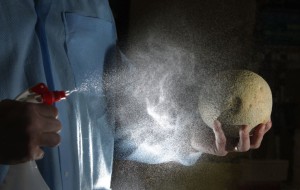Stephanie Lee of the San Francisco Chronicle, writes that to prevent and contain outbreaks of food-borne illness, which sicken 1 in 6
 Americans annually, a Bay Area startup is developing bar codes that go directly on fruits and vegetables. But you may overlook them: they’re DNA-size.
Americans annually, a Bay Area startup is developing bar codes that go directly on fruits and vegetables. But you may overlook them: they’re DNA-size.
Using technology invented at Lawrence Livermore National Laboratory, DNATrek is creating liquids that each contain a unique DNA sequence. The odorless, colorless and tasteless solution peppers the surface of produce, or blends into other oils and liquids, with a genetic bar code that can be identified by a special machine.
The technology could solve the enormous challenge of tracing an outbreak’s source — the places where food items are grown, packed and shipped. When people start feeling the symptoms of salmonella or E. coli, many clues about the contaminated product’s origins, such as the shipment boxes, already have disappeared.
The Food and Drug Administration has already recognized the invention as a safe food additive, but for now, the industry does not use it. After large-scale tests that are set to begin next year, DNATrek believes that its tool will emerge as a powerful weapon against food-borne illnesses, which cost the country an estimated $150 billion a year in health-related expenses, and counterfeit food products, which cost the global industry $10 billion to $15 billion annually.
DNATrek suggests that its bar codes may have come in handy in 2012, when an E. coli outbreak caused by contaminated spinach led 13 people to be hospitalized, and in 2011, when 33 Americans died after eating tainted cantaloupe. “If there’s a problem at home and there’s a piece of the cantaloupe left, you can pick it out of the trash, you can scrub the surface, and all the available information is there and you know exactly where it came from,” said Anthony Zografos, founder and CEO of the self-funded, three-employee startup that expects to close a round of seed funding by the end of the month.
Safety concerns
George Farquar, a physical chemist at Lawrence Livermore, patented the product in 2010 with about $3 million in research funding from the Department of Defense. Originally conceived as a biodefense tool, it combines FDA-approved foodstuffs, such as sugar, and a unique DNA sequence to create safe, inhalable microparticles for the purposes of tracking airflow indoors and outdoors. It has been used to test whether, for instance, air detection systems are able to notice particles that resemble anthrax. Last week, company executives and scientists traveled to the Pentagon to run their third series of tests.


